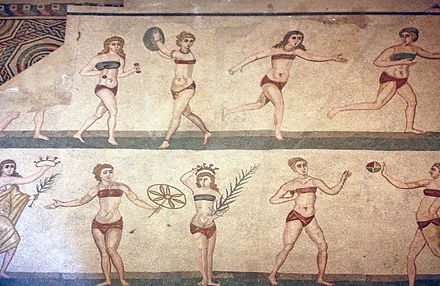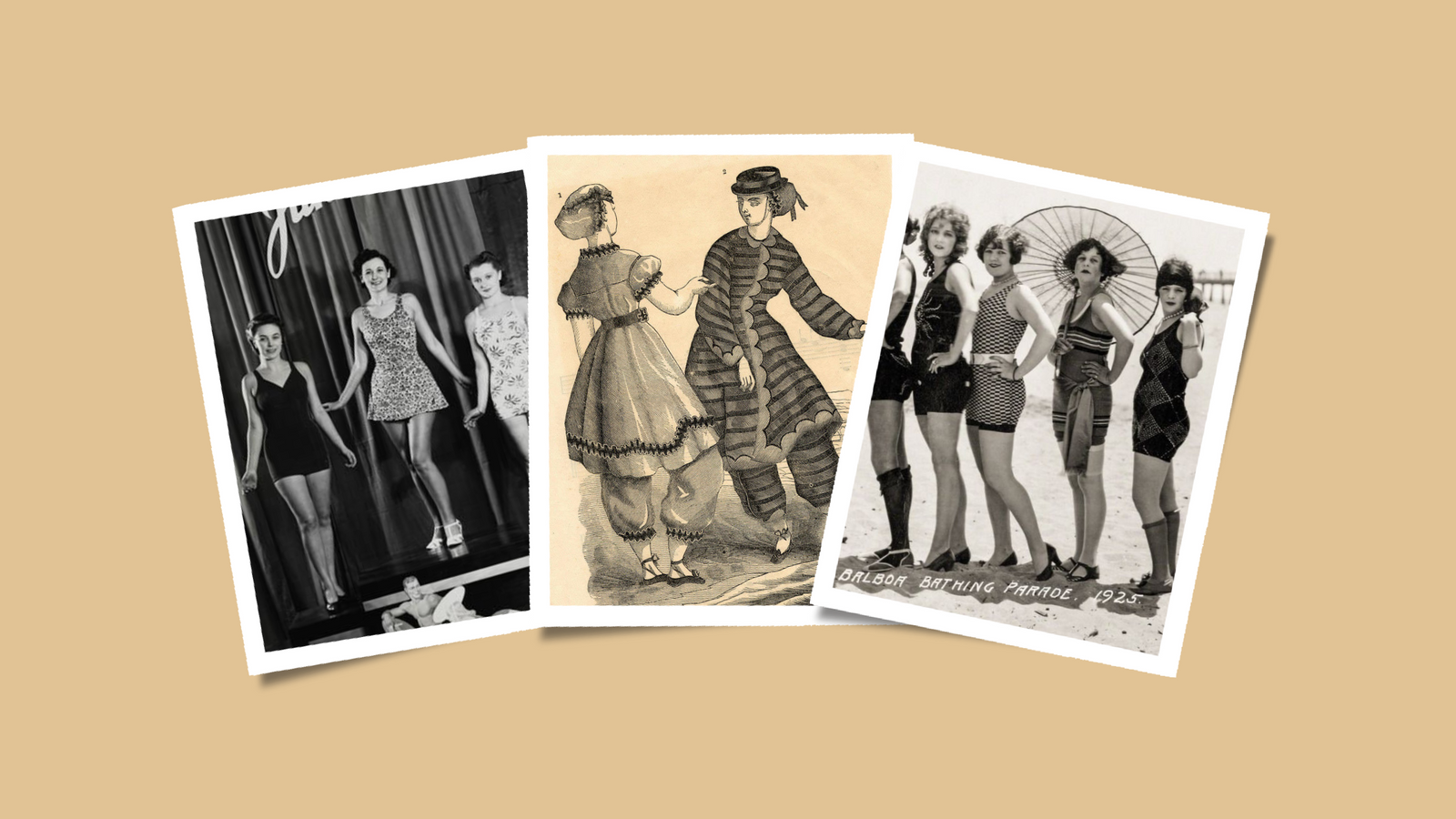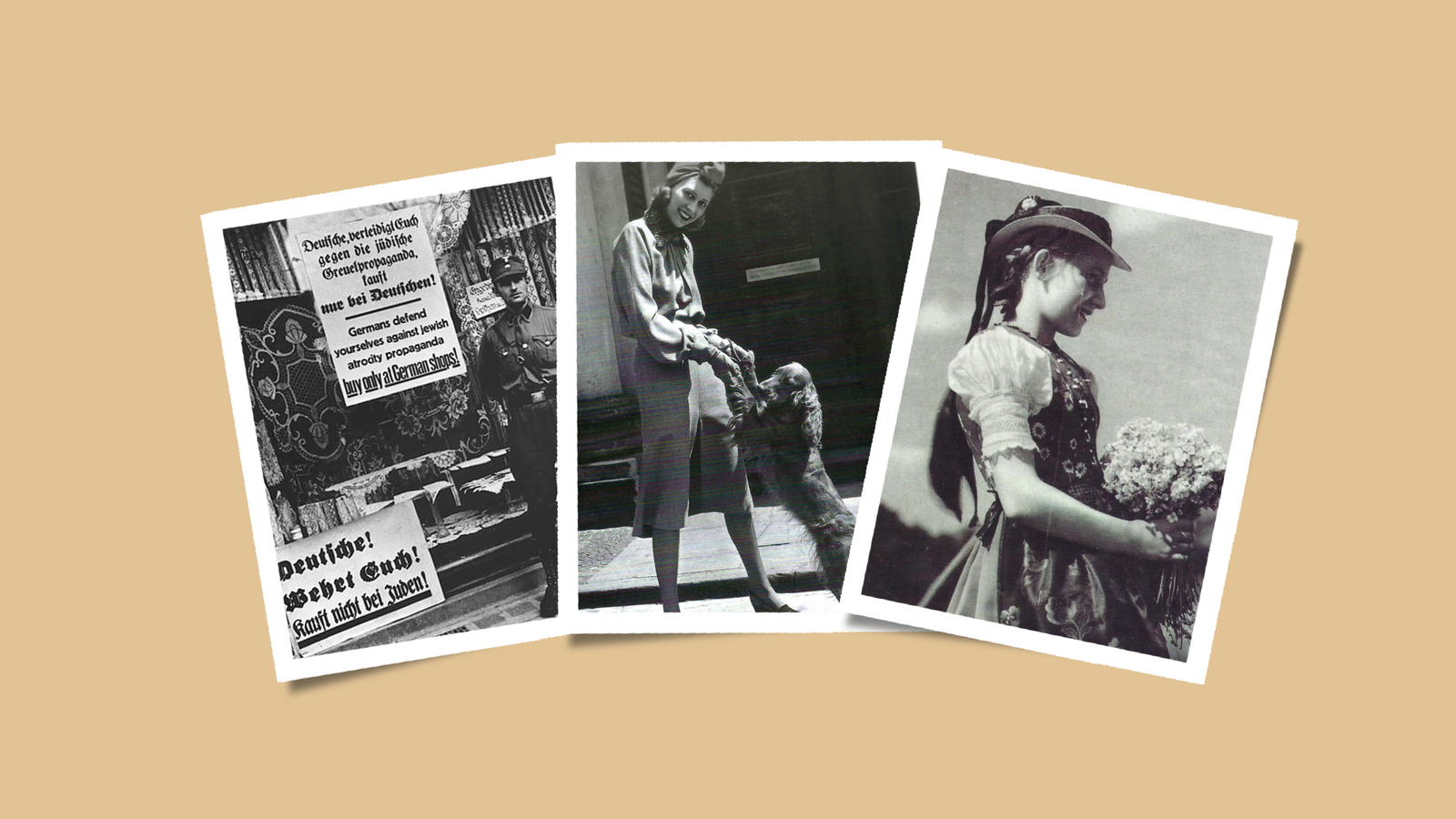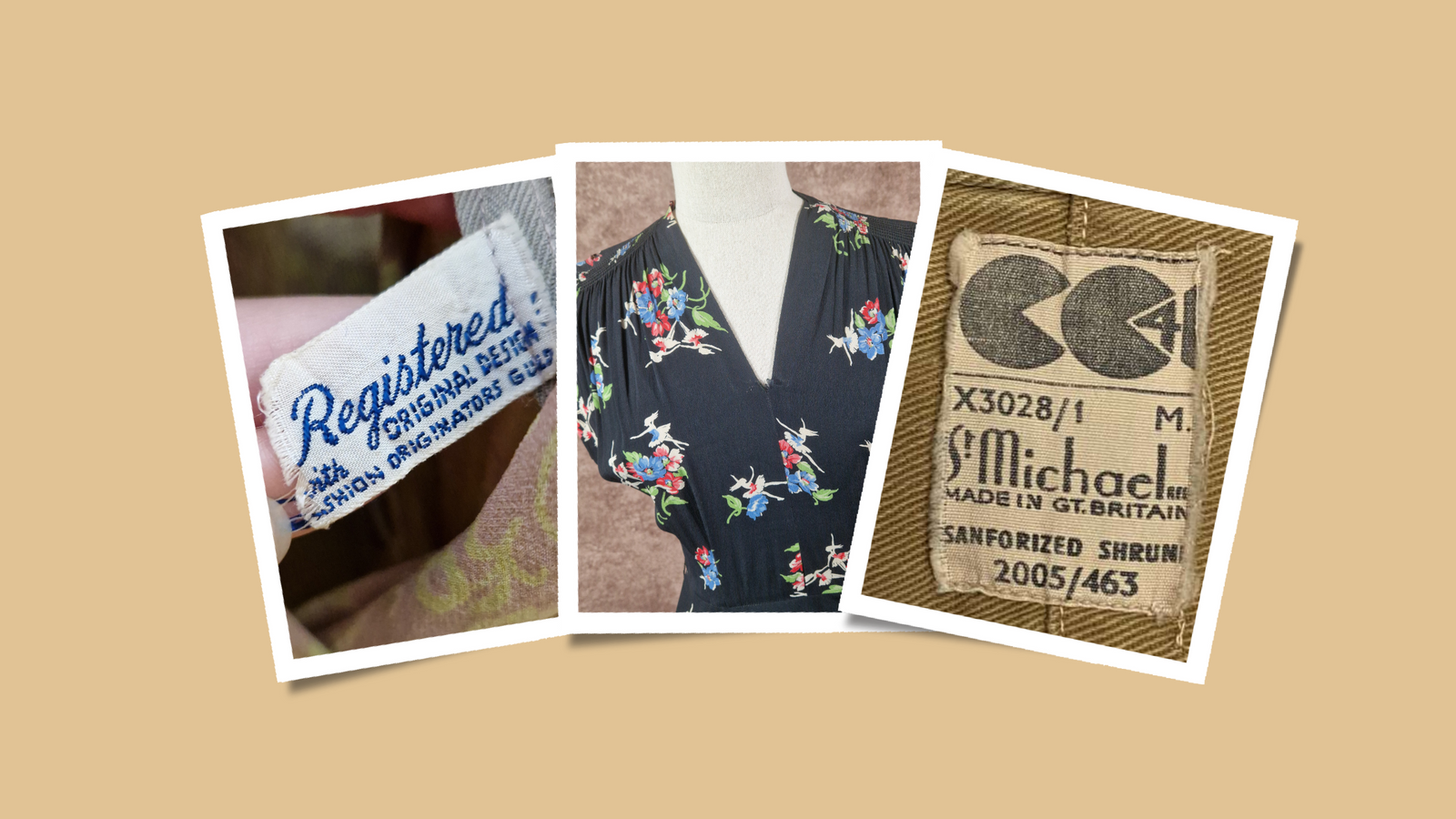Bikini and the Bomb: A History of Swimwear
We love to do nothing more in summer than relax at the beach! With the gorgeous weather, fashionable and functional swimwear is a must for many of us. But around 150 years ago if you wanted to go to the beach as a woman you would be wearing several layers of cumbersome cotton or flannel just to dip your toes - thankfully things have changed a lot since then, and swimwear is much more liberating for women now than it was all that time ago. But how did we go from wearing a multi-layered swim ensemble to our modern bikinis where sometimes almost nothing is left to the imagination?

Mosaic of Roman exercising women
Unsurprisingly, we’ve been wearing swimwear for thousands of years. 4th-century Roman women, as captured in this stunning mosaic, wore a simple two-piece outfit that covered the bust and hips allowing for easy movement when exercising or swimming. The two-piece outfit of the Roman women wouldn’t look that out of place at the beach today even though the bikini wasn’t ‘invented’ until the late 1940s.
The fall of the Roman Empire would see a decline in the popularity of water-based activities and sports. Across the continent, Europeans were quick to start viewing the ocean as a source of disease and uncleanliness among the higher classes. Bathing moved to be something exclusively done at bathhouses and was commonly done in the nude for both men and women. Britain in particular would take this even further and introduced restrictions on bathing attire and etiquette to ensure the modesty of baths, moving towards more prudish ideals despite people bathing communally for thousands of years.
Early 1800s bathing gown. Image source: victorianvoices.net
The 1700s would finally see the return of bathing in the sea as a popular pastime in Britain after years of being unfashionable, especially for the upper classes (taking a dip in the ocean had remained common for the peasantry population which accounted for the majority of the British public). Suddenly, the British aristocrats were bombarded with propaganda which told of the health benefits the chilly shoreline could provide them with. With advancements in medicine, the public was told that the shock of the cold waters of the British seas would stimulate their entire body, promoting blood circulation and restoring the body-soul balance of a person - some even recommended drinking seawater to help with leprosy.

1870s American bathing suit
Bathing costumes of the 1700s of course had to be worn whilst venturing into the sea. These outfits would compromise of a loose, open gown typically made from wool or flannel with a pair of bloomer-like trousers under the gown along with stockings/socks. The gowns were incredibly heavy when wet and restricted movement of the wearer, so ladies certainly wouldn’t be swimming the English Channel anytime soon. To make sure that the hem of the gown didn’t float up in the water and accidentally flash anyone, small lead weights were sewn into each quarter just above the hem, thus protecting a woman’s modesty whilst paddling.

1884 swimwear
Swimming/paddling for health benefits continued to be popular across Britain into the 1800s, but the public was now enjoying just being in the sea for leisure and fun (even if it was freezing cold). The industrial revolution that swept across the country had provided the population with new transport links which had never been available before, especially for the lower classes. Trains were able to travel all over the country and seaside locations were an instant hit with holidaymakers - even to this day you can still find Victorian-style architecture at popular UK seaside locations such as Brighton’s West Pier which burnt down in 2003 but remains a monument of its time.
Blackpool, UK, holiday advert promoted by Midland Railway. Image source: artworksconservation.co.uk
Women’s swimwear of the time still reflected the Victorian ideals of staying proper and modest, ensuring that women were still sufficiently covered to meet society’s expectations. Similar to the 1700s, bathing outfits consisted of a bathing dress with drawers and stockings underneath (the stockings made sure no bare legs were on display). The dresses now had much shorter arms so gave slightly more freedom of movement on top but were still heavy when wet.
Modesty was also maintained through bathing houses used to get in and out of the sea. These small sheds on wheels would be pushed out to sea and dragged back to shore, providing users with privacy when getting changed and stepping into the sea.
Funnily enough, until the mid-1800s there were no strict country-wide laws about bathing publicly in the nude which is surprising when considering the attitude of Victorian society. Each town in the country was free to make its own laws regarding nudity, but many of the lower classes still swam casually in rivers, lakes, and the sea fully nude - they had been doing it for hundreds of years after all. But as of 1860, it was illegal for men to swim nude in Britain (this had already been the case for women for some time) with many men protesting that they had to cover up whilst swimming.
Late 1800s/early 1900s bathing costumes. Image source: thevictorianhistorian.com
Towards the end of the 1800s, bathing outfits became a lot shorter and the stockings underneath were often abandoned. A new style of one-piece gained popularity, featuring a blouse that was attached to a pair of trousers with buttons. On top of this, there was a knee-length skirt to divert attention away from a woman’s lower figure. As time went on the under trousers became shorts, and the fabric was more lightweight and moved much better in the sea.
Annette Kellerman in her classic swimsuit. Image source: thevictorianhistorian.com
Annette Kellerman in particular further helped shift social attitudes and acceptance of female participation in swimming and helped the swimwear industry to modernise female swimwear in the early 1900s. Originally from Australia, Annette was widely praised for her underwater abilities and became known as “the Australian Mermaid”. She was famed for her attempts to swim the English Channel (although she wasn’t able to complete this after 3 separate attempts) and her performances in Hollywood movies such as “Neptune’s Daughter”. Her story was so influential at the time that in 1952 the biographical drama film “Million Dollar Mermaid” starring Esther Williams was made about Annette's life.

Neptune's Daughter starring Kellerman, 1914
Annette had a signature swimsuit which looks similar to what women wear for competitive swimming today, but her suit was a bit longer on her thighs. The older, layered, heavy swimsuits of days past were not a viable option for Annette’s performances and despite the controversy of showing off her bare skin, her more revealing swimsuit helped to make the style more fashionable and acceptable for women.

Article after Kellerman was arrested for public indecency in 1907 because of her 'revealing' swimsuit
1905 would see Annette receiving an invitation to perform for members of the British Royal Family, but her signature swimsuit wasn’t allowed to be shown before royalty. Her swimsuit was considered too tight-fitting and revealed too much bare skin on her legs which simply wasn’t acceptable to be shown in front of the Royal family. She refused to perform in older layered swim costumes, so she instead wore black stockings that were sewn into her swimsuit that gave her full coverage on her legs so she could perform. Ultimately, Annette Kellerman was able to make the one-piece swimsuit a more acceptable attire for women and would be a symbol of new freedom and liberation in women’s fashion.
“I can’t swim wearing more stuff than you hang on a clothesline” - Annette Kellerman
The early 1900s saw fashion revolutionising and becoming more liberal and less restrictive thanks to icons like Annette Kellerman. Clothing manufacturers had been developing and advancing their materials to give way to a range of new fashion options for both land and sea. But one of the most significant turning points for the swimwear revolution was in 1912.

Britains first Olympic Women's Swimming Team, 2012
Revitalised with a new lease of life, the first modern Olympic Games hosted in Athens in 1896 reintroduced competitive swimming for men, creating a surge in popularity from the British public in the sport. Eventually, women were allowed to also compete in their own competitions at the 1912 Stockholm Olympic Games. Women wore one-piece swimsuits which exposed the arms, with hemlines finishing mid-thigh much like Annette Kellerman’s swimwear. However, public nudity was still quite a concern with these changes in swimwear, and it was part of the reason why there wasn’t an American female swimming team for the 1912 Olympics.
The years after the First World War would see women’s swimsuit trends differing across the continents. American swimwear designs tended to lean towards being more practical and sport-orientated due to American women being encouraged to take up sports to be healthy. Across the pond in Europe, France in particular, swimwear was sleeker in design, cut closely to the body, and became more of a fashion statement for relaxing in than functional swimwear. These designs were heavily influenced by the fashion capital of Paris and tended to be reserved for the higher classes. French swimsuits were shorter on the legs than their American counterparts and made from knitted and finely woven wool. This fabric may have looked great but would become misshapen when wet and appeared saggy and terribly unflattering. Despite the differences in popular staples, the one-piece swimsuit remained a solid popular option for women regardless of country or social class.
Jantzen, originally known as the Portland Knitting Company, pushed for the popularity of women’s swimwear and is still selling it to this day. The company revealed their first swimsuit in 1913 which weighed 8 pounds when wet - incredibly lighter than previous designs. Jantzen was the first company who was the first to become dedicated to making women’s swimwear and also played a large role in promoting swimming as a sport. The company arranged for people to be taught how to swim, thus creating and expanding the market for their garments.

Advert for Jantzen swimwear
It did take longer for Britain to catch up with the popularity of the one-piece swimsuit thanks to lingering concerns over the exposure of bare legs and arms being a bit too scandalous, but demand would eventually overcome these social barriers.
Balboa Bathing Parade, 1925. Image source: shorpy.com
The fabulous fashion of the 1920s influenced swimwear to feature more intricate and decorative features. Growing demand for comfortable, flattering and stylish swimwear led to rapid changes within the textile industry, as manufacturers competed to be at the forefront of newly emerging fashion trends. Lastex (a type of elastic yarn) paved the way for new waterproof garments to be made. The fashion industry wasn’t the only ones eager to jump on these sweeping trends as Hollywood took advantage to show off their actresses' figures.

An image showing evolution of swimwear, 1927
Film producers of the 1930s pushed the limits of what they could get away with when dressing their star ladies, sidestepping the Hays Code to feature as much swimwear as possible in their films. The Hays Code was a set of industry guidelines for self-censorship which applied to the majority of films released by major US studios from 1934 until 1968. The code set out what was acceptable and unacceptable content for public audiences. Lingerie was a big no on the silver screen, but swimwear wasn’t subject to the same rules and was written into as many scripts as possible to replace lingerie to draw-in cinemagoers.

Joan Blondell & Bette Davis, posing for publicity photos in 1932 for their film "Three on a Match"
An early form of product placement took place as swimwear companies signed film stars to model their costumes and herald the arrival of their innovative designs, waterproof fabrics, and figure-enhancing improvements. Women in both the UK and the US were eager to look like the silver screen beauties and flocked to buy the latest swimwear trends. Soon swimming baths and open-air-lidos were becoming new glamorous gathering points for parading the latest styles.

Swimsuit police measuring swimsuit length
Swimwear did still meet some resistance and on some American beaches were subject to strict policing with their garments. The “Swimsuit Police” patrolled beaches to ensure that women's swimsuits weren’t cut too short on the thigh. If these men thought a swimsuit was too short a tape measure was pulled out to measure the distance from hem to knee to see if the lady was compliant with local rules. If her swimsuit was too short a formal warning could be given or even a short trip to jail.
Women arrested in Chicago, US. 1922. Image source: vintag.es
These punishments and restrictions fizzled out towards the end of the 1930s. The one-piece costume ceased to be scandalous, and Western women were revealing more of their bodies whilst sunbathing and swimming. The promenade became a fashion parade for the latest styles and created yet another new market for swim/summer fashions, especially as the two-piece swimsuit had started to gain popularity towards the 1940s. These two-piece costumes always covered the navel and finished level with the thigh (same as the one-piece) and had a full coverage bra-like top.

1930s holiday advert for Brighton and Hove, UK

Actress Francis Dee in a popular 1930s style
Whilst fashion has been rapidly evolving in recent decades, the Second World War halted fashion from its usual path of progression and demanded innovation to meet rationing and material restrictions. Fashion had never before used so little fabric as short sleeves, knee-length skirts, and figure-hugging styles had become the standard for wartime fashion.

Jantzen advert showing different skirt styles for swimsuits
Early 1940s one-piece costumes were still popular at the time as fabric rationing hadn’t hit the textile industry at full force yet. The costumes resembled a tight, short dress which extended down to cover the backside completely. Skirts were either snug fitting around the hips or a looser swing style. Necklines began to vary as fabric became more in demand, with strapless sweetheart necklines and halter neck styles helping save on small amounts of fabric.

Cole of California advert with actress Esther Williams
But as with many things during the Second World War, swimwear design and manufacturing had moved down the list of priorities for wartime production. The demand for swimwear was still present thanks to Hollywood films, but American fabric rationing in particular had demanded a 10 per cent reduction in the amount of fabric used for swimwear, leaving designers to rethink their styles.

Popular 1940s swimwear fashion
Rationing meant that fabrichadto be cut somewhere from swimsuits. There was much experimentation with different parts of the swimming costume cut out, variations in front-fastening ties, and different kinds of straps but ultimately the only place a sizeable amount of fabric could be saved from the midriff - thus the two-piece suit had its time to shine. These designs revealed more waist and bust than ever before, but still, the naval remained covered. The more revealing nature of this style was actively promoted on-screen and in advertising to appeal to a male audience wanting a distraction from war, whilst also targeting women who wanted to wear the latest styles from Hollywood. The pin-up girls of the 1940s made the two-piece costume a staple, with heart-shaped necklines accessorised with perfect hair and make-up for photographs which would hopefully boost the morale of the soldiers collecting their pictures.

Rita Hayworth for LIFE Magazine, 1945
1946 would see the creation of the ‘bikini’, a natural development of the two-piece and wartime rationing which used minimal fabric.
Parisian designer Jacques Heim took the bare midriff a step further by exposing the naval in a two-piece costume he named his “L’Atome”, after the smallest thing in the world - the atom. Heim launched his new design and hired a plane to write in the sky “The world’s smallest bathing suit” right above the fashionable Cannes beach in France.
In less than two weeks' time, Heim’s design was knocked off its pedestal as being the smallest bathing suit by a design which was absolutely scandalous. Louis Réard, a car engineer and fashion designer created something which was “Smaller than the smallest swimsuit”, with the bottoms being even smaller than Heim’s design and revealing the naval - something that hadn't been publicly acceptable on women’s bodies for hundreds of years. Réard named his design the ‘Bikini Atoll’ after the location in the South Pacific where an atomic bomb was tested by the US during the war.

Micheline Bernardini wearing the bikini, which could fit in the small box she was holding
The bikini was made from less than a square foot of fabric and consisted of only four triangles which were held together with string, much like our modern bikini styles. Réard hired 18-year-old nude showgirl Micheline Bernardini to model his creation for the Paris fashion press (he had tried to find a runway fashion model to showcase his design, but the models refused as it was too revealing due to the exposures of the naval and the buttocks). Unsurprisingly the bikini was a hit with men, and Bernardini received over 50,000 fan letters after the publicity stunt.
Heim and Réard’s designers competed for public attention, and whilst Heim’s design was the first to be worn on a beach and become the popular style, it was the name bikini from Réard that stuck. Unfortunately for Réard, his design was too revealing for the majority of women in the late 1940s and was banned on some public beaches until the 1950s.

"Manina, the Girl in the Bikini", 1952
But the continued success of the film industry and Hollywood glamour had a big impact on swimwear in the 1950s and would see the bikini finally becoming popular despite being designed in the previous decade. In 1952, 17-year-old Brigitte Bardot starred in the French film "Manina, the Girl in the Bikini" and was the first woman to wear Réard’s bikini on the big screen and into popularity.

A young Brigitte Bardot wearing the bikini at the Cannes beaches
The bikini continued to receive mainstream media exposure, thus beginning the garments transition from outrageous and shocking to everyday beach wear. According to Vogue, by the 1950s swimwear was seen more as a “state of dress, not undress”, and further advancements in fabrics meant swimwear could now be produced in a larger range of colours and prints.

Marilyn Monroe, 1956
Although the bikini had seen success thanks to Bardot, the one-piece costume also became popular again thanks to relaxing fabric rationing and actresses like Marilyn Monroe and the popularity of pin-up girls revitalising the style.
Modern swimwear pays homage to a vintage inspiration more than any other genre of fashion. The curvaceous swimsuits and bikinis of the celebrated pin-up girls of the past have been shaped to combine the best of both sportswear and lingerie to create garments that truly flatter the wide variety of female figures we have today.












Next level suit
October 16, 2024
This sounds fascinating! It’s amazing to see how swimwear has evolved over the years, reflecting changes in fashion, culture, and body positivity. Can’t wait to dive into the details and learn more about the trends that shaped our beach days! 🏖️✨